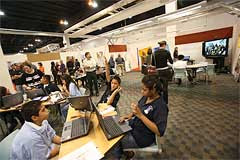 Recently local developer, Urban Ventrues and respected architect Michelle Kaufman announced that they will be partnering on a Green, Sustainable community development here in Denver. The project is called Aria Denver. As a result of that announcment, I found Michelle's blog and have been following it ever since.
Recently local developer, Urban Ventrues and respected architect Michelle Kaufman announced that they will be partnering on a Green, Sustainable community development here in Denver. The project is called Aria Denver. As a result of that announcment, I found Michelle's blog and have been following it ever since.I'm really glad I have been because she has some very interesting and thought provoking posts. Yesterday's post was one of those. She brought to my attention a design competition currently underway and sponsored by Open Architecture Network. The idea is for local architects and designers to partner with a local school to help design a classroom of the future. Something that is smart, safe and sustainable. Because this is through the Open Architecture Network, any designs that win the competition would make their design available worldwide through some type of open copyright. This is opensource software for architects! What a great idea. The reason for the competition is to address the fact that (according to the World Bank), educating all children worldwide will require the construction of 10 million new classrooms in more than 100 countries by 2015.
MediaLogix partnered with local architecture firm, Bennett Wagner Grody to design a similar classroom for the National Middle School Association show in Denver last year. Actually, I should say that Bennet Wagner Grody designed the classroom and MediaLogix designed the technology systems.
So, who is up for it? Any architects out there interested in taking on the challenge? We know that technology is an integral part of future classrooms. It enables better presentation/learning environments and the ability to connect in a multitude of ways. We have some great ideas so lets get started!









